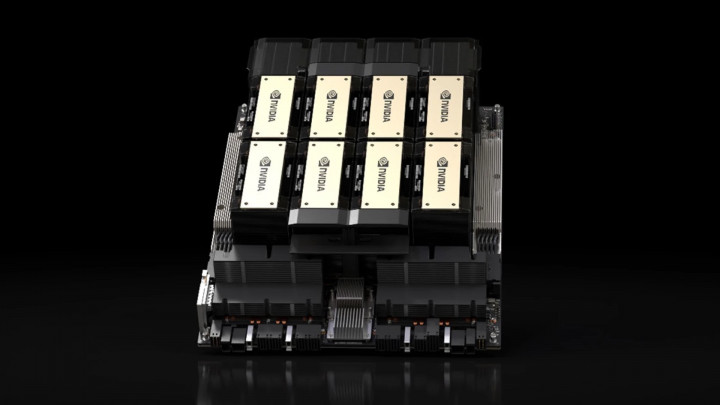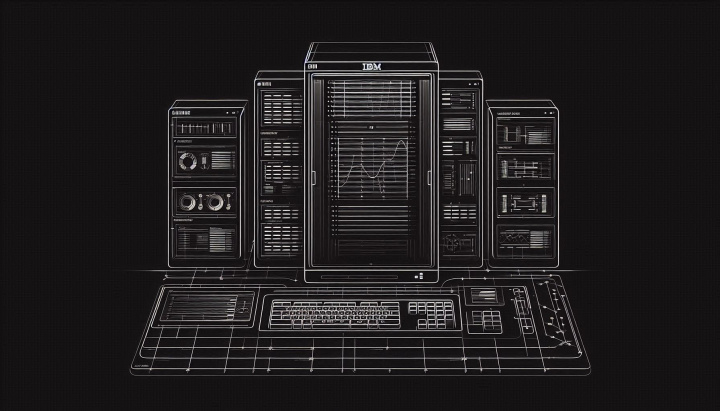Why Does NVIDIA Dominate the AI GPU Market?
The advancement of machine learning and large language models (LLMs) has created computational challenges that require much more than simple hardware upgrades. The artificial intelligence explosion of recent years has generated specialized computing demands for which NVIDIA currently offers almost exclusive solutions.

The Roots of NVIDIA's Technological Superiority
Specialized Hardware Solutions
The key to NVIDIA's success lies in the specialized development of its Tensor Cores. These dedicated hardware units not only perform parallel computations but are specifically optimized for artificial intelligence operations. They offer three critical technological advantages:
- Accelerated Matrix Multiplication: Extremely efficient execution of the most crucial operation in neural networks.
- Mixed-Precision Computing: Capable of converting between different numerical formats in real-time, allowing for increased computational speed while maintaining acceptable accuracy, optimizing performance and memory usage.
- Deep Learning Optimizations: Built-in support for the most common operations in neural networks.
Software Ecosystem
NVIDIA doesn't just manufacture hardware; it provides a complete software infrastructure:
- Its CUDA platform
- cuDNN libraries
- TensorRT optimization tools
- Extensive developer support
This mature and widely adopted ecosystem significantly simplifies developers' work and ensures maximum hardware utilization, creating a substantial barrier to entry for competitors.
The Position of Competitors
AMD is Catching Up
AMD's ROCm platform (AMD's software platform similar to CUDA) is becoming competitive, but it currently lags behind NVIDIA:
- Limited AI-specific hardware acceleration features compared to Tensor Cores.
- Less mature software ecosystem.
- Smaller developer community.
- Often more cost-effective hardware, offering a trade-off.
Intel is Investing Heavily
Intel is channeling significant resources into catching up with its Xe GPU architecture and dedicated AI accelerators (like the Gaudi series):
- Serious R&D investments.
- Promising semiconductor experience.
- Gaudi 3 accelerators are now available and show competitive performance in specific LLM tasks against NVIDIA's H100/H200, aiming to capture market share, especially where NVIDIA supply is constrained.
- Still developing its AI hardware solutions and ecosystem compared to NVIDIA's lead.
Why Not All GPUs Are Suitable for AI Tasks?
Hardware Limitations
- Lack of Tensor Cores
- Not all GPUs have dedicated AI accelerator cores.
- Older generation cards are only suitable for general-purpose computing.
- Memory Type and Size
- Large LLMs require at least 40-80 GB of memory, while models with tens or hundreds of billions of parameters need multiples of this value.
- Differences between HBM (High Bandwidth Memory) and GDDR technologies: HBM typically offers higher bandwidth and is closer to the GPU chip, critical for large models, while GDDR is more common in consumer cards.
- Bandwidth is critically important.
- Energy Efficiency
- AI tasks are extremely energy-intensive.
- Not all cards are capable of efficient heat dissipation and handling continuous load.
Software Compatibility
- Not all frameworks support different GPUs equally.
- CUDA has become the de facto standard.
- Open-source alternatives (like ROCm) have limitations in maturity and breadth of support, though they are improving.
The Role of GPUs in LLM Inference
During the inference phase of large language models (LLMs), GPUs (Graphics Processing Units) play a key role in providing computational power. LLM operations are based on numerous matrix calculations that require parallel processing for efficient execution. GPUs, with their thousands of cores, can perform large matrix multiplications and other tensor-based operations in parallel, significantly reducing inference latency. Architectures like NVIDIA's Tensor Cores or AMD's AI accelerators are specifically optimized for machine learning tasks, making LLM execution more efficient.
GPUs are advantageous not only for performance but also for energy efficiency during LLM inference. While CPUs can also run LLMs, GPUs produce significantly faster results with lower energy consumption due to their vastly superior parallelization capabilities. Furthermore, common solutions in modern AI infrastructures, such as multi-GPU scaling or dedicated AI accelerators (e.g., NVIDIA A100, H100, H200, AMD Instinct MI300 series, Intel Gaudi 3), further enhance processing speed, enabling real-time or near-real-time use of LLMs in chatbots, search engines, and other AI-based applications.
Key NVIDIA GPUs for LLM Inference
| GPU Model | Architecture | Target Market | Tensor Core Generation | CUDA Cores | Tensor Cores | Memory | Memory Bandwidth | Power Consumption (TDP) |
|---|---|---|---|---|---|---|---|---|
| NVIDIA H200 SXM | Hopper | Data Center | 4th | 16,896 | 528 | 141GB HBM3e | 4.8 TB/s | Up to 700W |
| NVIDIA H100 SXM | Hopper | Data Center | 4th | 16,896 | 528 | 80GB HBM3 | 3.35 TB/s | Up to 700W |
| NVIDIA A100 (80GB) | Ampere | Data Center | 3rd | 6,912 | 432 | 80GB HBM2e | ~2 TB/s | 400W |
| NVIDIA L40S | Ada Lovelace | Data Center | 4th | 18,176 | 568 | 48GB GDDR6 | 0.86 TB/s | 350W |
| NVIDIA T4 | Turing | Data Center | 2nd | 2,560 | 320 | 16GB GDDR6 | 0.32 TB/s | 70W |
| NVIDIA Tesla P40 | Pascal | Data Center | N/A | 3,840 | N/A | 24 GB GDDR5 | 0.34 TB/s | 250W |
| NVIDIA RTX 5090 | Blackwell | Consumer / Prosumer | 5th | 21,760 | 680 | 32GB GDDR7 | 1.79 TB/s | 575W |
| NVIDIA RTX 4090 | Ada Lovelace | Consumer / Prosumer | 4th | 16,384 | 512 | 24GB GDDR6X | 1 TB/s | 450W |
Note: Specs like CUDA/Tensor core counts can vary slightly between specific card models (e.g., SXM vs. PCIe). Values shown are typical or maximums for the indicated model/architecture. RTX 5090 Tensor Core count is estimated.
Pros and Cons
| GPU Model | Pros | Cons |
| NVIDIA H200/H100 | - Peak performance for massive LLMs - Huge memory capacity & bandwidth (HBM) |
- Extremely high cost - High power consumption & heat |
| NVIDIA A100 | - Excellent performance, widely adopted - Still very capable for many models |
- Still expensive - High power consumption |
| NVIDIA L40S | - Strong performance for inference/graphics - Better price/performance than H100 for some tasks - More energy efficient than top-tier |
- Lower memory bandwidth (GDDR6) - Still a significant investment |
| NVIDIA RTX 5090 / 4090 | - Excellent price-to-performance ratio - Readily available (consumer market) - Relatively affordable for the power |
- Smaller memory capacity vs. data center cards - Not designed for continuous data center operation (drivers, cooling, support limitations) |
| NVIDIA T4 | - Low power consumption - Cost-effective for inference - Widely supported on cloud platforms |
- Lower raw performance - Limited memory |
Selection Criteria
When choosing the right GPU, consider:
- The size of the model(s) you plan to run
- Performance requirements (latency, throughput)
- Available budget
- Power supply and cooling capabilities
Cost Optimization Strategies
- Scale infrastructure according to actual needs (don't overprovision).
- Use efficient batch processing and mixed-precision inference.
- Optimize the model architecture (if possible).
- Apply model compression techniques (quantization, pruning).
- Consider cloud-based GPU resources vs. building on-premise infrastructure.
GPU Suitability for AI Tasks
| Category | Suitability | Key Criteria |
|---|---|---|
| Excellent (Top Tier) | H200, H100, A100 (80GB) | - 80+ GB High Bandwidth Memory (HBM3e/HBM3/HBM2e) - Latest generation dedicated Tensor Cores - Designed for massive scale-out |
| Very Good | L40S, RTX 5090 |
- 32-48 GB Memory (GDDR7/GDDR6) |
| Good | A100 (40GB), RTX 4090, T4 |
- 16-40 GB Memory |
| Limited | Older gaming GPUs (e.g., RTX 30 series, older Teslas like P40) | - Less memory (often < 24GB) - Older or missing AI-specific cores - Lower memory bandwidth |
| Not Suitable | Integrated graphics, very old GPUs | - Minimal memory - Lack of parallel compute capability / AI features |
Summary
NVIDIA is currently not just a GPU manufacturer but the creator of an entire AI ecosystem. Its technological advantage lies not in a single hardware solution but in a complex, integrated system combining cutting-edge hardware with a mature and widely adopted software platform.





